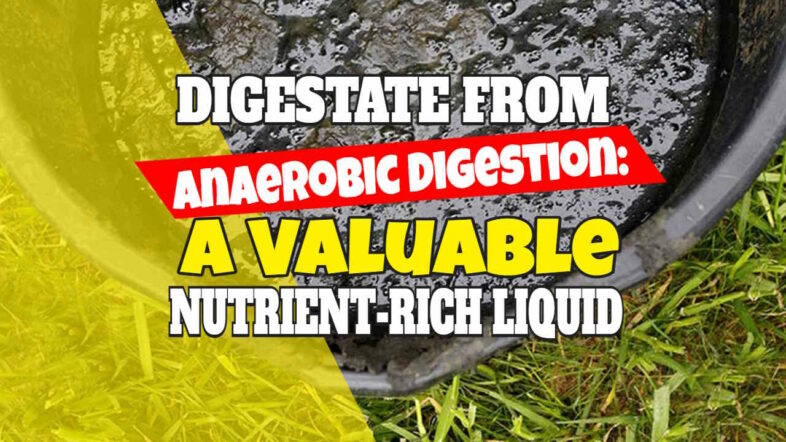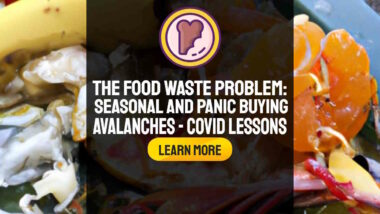Using digestate from Anaerobic Digestion provides a valuable plant fertiliser. In fact, unlocking the potential of digestate is vital for the sustainability of the agriculture sector. There is nothing else quite as good when you take a holistic view of its many benefits.
Digestate is a valuable nutrient-rich liquid produced from the process of anaerobic digestion. It is a by-product of the biogas generation process, and its value as a fertilizer has been recognized in recent years.
Digestate contains a range of plant nutrients, including nitrogen, phosphorus, and potassium, making it an excellent source of fertilizer for crops. With the increasing demand for sustainable agriculture practices, the use of digestate has become a popular choice for farmers who are looking for ways to reduce their environmental impact. However, the full potential of digestate from Anaerobic Digestion (Ad) has yet to be realized.
It is important to note that digestate cannot be used in its raw form as it may contain harmful pathogens and weed seeds. There is still a lot of work to be done to explore the various methods of digestate application and its effectiveness on different crop types.
Advanced digestate treatment technologies are needed to ensure the safe use of digestate from Anaerobic Digestion as a fertilizer. Digestate treatment technology not only reduces the risk of soil contamination but also increases digestate’s nutrient efficiency.
By unlocking the potential of digestate, farmers can reduce their reliance on traditional non-renewable chemical fertilizers, which are harmful to the environment.
With the scientific and agricultural communities acting together, we can create a sustainable future for agriculture, and digestate offers a valuable opportunity to achieve this goal.

Variation in Digestate Properties Based on Feedstock and Anaerobic Digestion Process
Anaerobic digestion is an eco-friendly solution for waste disposal and renewable energy generation. The nature of the feedstock and the type of anaerobic digestion process are two major factors that determine the properties of the resultant digestate. As most anaerobic digestion today uses single-stage CSTR technology, this article refers to CSTR AD plants.
The properties of digestate from Anaerobic Digestion are of paramount importance as they directly impact the efficacy of the end product as a fertiliser and will make the difference between a marketable product or an output viable only for local land spreading.
The composition of feedstock that goes into the digester affects the nutrient content, pH, and C/N ratio of Digestate from Anaerobic Digestion. Different feedstocks such as animal manure, food waste, and crop residues have distinct characteristics, thus resulting in variations in digestate properties.
The design and operation of the digester, including temperature, solids retention time, and hydraulic retention time, have significant effects on nutrient content, pH, and organic matter degradation of digestate from Anaerobic Digestion.
Therefore, when the Digestate from Anaerobic Digestion is to be sold as a product understanding the variation in digestate properties based on feedstock and the anaerobic digestion process is crucial not only for optimizing processing efficiency but also maximizing the value of digestate from Anaerobic Digestion.
There is a whole new level of control and monitoring which is needed for a biogas plant as soon as it is intended to sell a digestate product, while at the same time creating substantial added value.
In conclusion, proper management of feedstock and the anaerobic digestion process plays an integral role in determining the properties of digestate from Anaerobic Digestion. This is critical for achieving not only sustainable waste management and renewable energy generation but the sort of renewable low-carbon fertilisers so badly needed if nations are to achieve their Net-Zero climate change amelioration 2050 targets.

Understanding the Nutrient and pH Characteristics of Digestates from Anaerobic Digestion
Anaerobic digestion is a process that breaks down organic matter in the absence of oxygen, producing nutrient-rich digestates that can be used as fertilizers (in liquor or fibrous from) or even (for the fibre) biofuels.
But, understanding the nutrient and pH characteristics of these digestates when used as fertilisers is paramount for their effective utilization.
In the rest of this article, we refer to the separated digestate liquor (usually separated from the fibre using an auger screw press), unless stated otherwise.
Nutrient levels in digestates depend on the source material, and as such, the nutrient composition of digestates can vary significantly. While digestates contain various essential nutrients, including nitrogen, phosphorus, and potassium, they may also harbour trace elements and heavy metals that can pose environmental risks if not managed appropriately.
pH is another crucial characteristic of digestates as it influences microbial activity in the soil, affecting nutrient availability and plant growth. Therefore, it is crucial to monitor the pH levels of digestates and their effects on the surrounding environment.
By understanding the nutrient and pH characteristics of digestates from anaerobic digestion, users can better manage their application to maximize their benefits while minimizing environmental impacts.
Further research into the composition of digestates can lead to more effective and sustainable use of these valuable resources, contributing to the circular economy and promoting sustainable development.

Variability in Electrical Conductivity and Nitrogen Content of Digestates from Anaerobic Digestion
Anaerobic digestion is an effective and efficient way to transform organic waste into biogas, a renewable energy source, and digestate, a nutrient-rich fertilizer. However, as already noted here, the quality of Digestate from Anaerobic DigestionDigestate from Anaerobic Digestion can vary depending on the composition of the feedstock and the operating conditions of the digester.
In particular, the electrical conductivity and nitrogen content of digestates can vary significantly, which has important implications for their agricultural use.
High electrical conductivity can indicate a high concentration of salts, which can lead to soil salinization, while low nitrogen content can limit the fertilizing value of the digestate. Therefore, understanding and controlling the variability of these parameters is critical for maximizing the benefits of anaerobic digestion.
Several factors can affect the electrical conductivity and nitrogen content of digestates, including the type and quality of the feedstock, the retention time in the digester, and the post-digestion treatment. By optimizing these factors, it is possible to produce digestates with consistent and desirable properties for agricultural use.
Moreover, the variability of electrical conductivity and nitrogen content can be used as a diagnostic tool to monitor and optimize the performance of anaerobic digesters.
Overall, understanding the variability of electrical conductivity and nitrogen content of digestates is essential for the sustainable management of organic waste and the production of renewable energy and fertilizers.
Analysis of Nitrogen Content in Liquid Digestates from Anaerobic Digestion Sites in the UK
The analysis of nitrogen content in liquid digestates from anaerobic digestion sites in the UK is a crucial aspect of ensuring proper management of this by-product.
Anaerobic digestion is an environmentally friendly process that produces energy from organic waste, and the liquid digestates produced as a by-product contain high levels of nitrogen, which can be used as a fertiliser. However, improper management of these liquid digestates can lead to pollution of the environment and pose a risk to human health.
Therefore, it is essential to analyse the nitrogen content in these liquid digestates and identify appropriate methods for their safe disposal should the levels be so high as to present a negative effect when applied as a fertiliser. The analysis of nitrogen content is a complex process that involves several analytical techniques, including titration, spectrophotometry, and chromatography.
These methods enable the identification and quantification of various forms of nitrogen, such as ammonium, nitrate, and organic nitrogen. The results of this analysis can be used to determine the fertilising potential of the liquid digestates and assess their suitability for agricultural use. In conclusion, the analysis of nitrogen content in liquid digestates from anaerobic digestion sites in the UK is an important aspect of waste management.
By conducting this analysis, we can ensure that these by-products are utilised safely and sustainably, and are not harmful to the environment or human health. Therefore, it is vital that anaerobic digestion sites in the UK continue to conduct regular nitrogen content analyses to ensure the safe disposal of liquid digestates with excess nitrogen.
Variability of Nitrogen Content in Digestates from Food Waste and Maize Anaerobic Digestion Processes.
The variability of nitrogen content in digestates from food waste and maize anaerobic digestion processes is an important area of study for agricultural, environmental, and waste management sectors. The anaerobic digestion process is a promising technique for converting organic waste materials into biogas and digestates.
The nitrogen content in the digestates is an essential factor for sustainable use as a fertilizer. However, the nitrogen content is variable depending on the feedstock and the anaerobic digestion process conditions. Therefore, it is crucial to assess the variability of nitrogen content in digestates from different sources.
Recent studies have shown that the nitrogen content in digestates from maize feedstock is higher and more stable than food waste feedstock. The higher nitrogen content in maize digestates is due to the higher nitrogen content in maize compared to food waste.
The study also revealed that the nitrogen content in digestates from food waste may be present at a beneficial level for its use as a fertiliser. However, environmental impact was affected by the presence of contaminants such as plastics, metals, and other non-biodegradable materials.
The presence of these contaminants if allowed in the fertiliser would build up in the soil with damaging effects. Many Environmental Regulators wisely monitor and control the maximum values of these contaminants and prohibit the use of digestates that exceed the permissible limits.
This hinders its use as a fertilizer unless the contaminants are removed by waste processing. In conclusion, the variability of nitrogen content in digestates from food waste and maize anaerobic digestion processes is an essential factor for sustainable waste management. The findings from recent studies suggest that maize feedstock is a more reliable source of nitrogen-rich digestates compared to food waste.
However, the study recommends further research to understand the impact of contaminants and other factors affecting the nitrogen content in digestate, from Anaerobic Digestion, for optimal use as a fertilizer.
Liquor Nutrient Content and Fibre Properties of Food Waste Digestates from Anaerobic Digestion.
The practical and sustainable management of food waste is a key challenge facing our society today. Anaerobic digestion (AD) technology is considered a promising solution for treating food waste and generating renewable energy.
The resulting digestates from AD systems have the potential to act as valuable fertilizers, contributing to soil health and promoting plant growth.
A number of studies have been published in which the researchers investigated the nutrient content and fibre properties of food waste digestates from anaerobic digestion. The findings demonstrate that the digestate provides a significant source of valuable plant nutrients, including nitrogen, phosphorus, and potassium.
Moreover, the fibre fraction of the digestate is demonstrated to have the potential for use as a feedstock for the production of high-value products such as biochar, which is widely used in agricultural and horticultural applications.
The research provides important insights into the value of digestate as a resource, highlighting its potential to contribute to a circular economy. Overall, a recent study presents a compelling case for the effective management of food waste through AD technology, promoting resource sustainability and contributing to the transition towards a more circular economy.
Micronutrient analysis of digestates and the presence of boron, copper, iron, manganese and zinc
Micronutrient analysis is an essential tool for identifying and quantifying the presence of vital elements in digestates. The analysis of these elements, such as boron, copper, iron, manganese and zinc, is vital for the optimization of soil fertility and plant growth.
The digestion process is vital in the conversion of organic matter into nutrients that can be reused and recycled. The presence of these micronutrients in digestates provides a unique opportunity for their utilization in agriculture through the application of digestate as a fertilizer.
Boron, copper, iron, manganese and zinc each provide traces of substances essential for productive healthy plant growth.
Boron is essential for root development and is critical in the production of cell walls. It also aids in the regulation of other plant nutrients.
Copper is essential for the metabolism of carbohydrates and proteins and also acts as a catalyst in photosynthesis. Iron is vital for the production of chlorophyll and is thus essential for healthy plant growth.
Manganese is necessary for the formation of enzymes responsible for the metabolism of nitrogen and carbohydrates.
Zinc is critical in the metabolism of carbohydrates, proteins, and plant hormones, all of which are vital for plant growth and development. Therefore, the analysis of micronutrient elements in digestates is crucial in providing the necessary information for the formulation of balanced fertilizers.
Maximizing Nutrient Value: Understanding and Planning for the Use of Digestates from Anaerobic Digestion
Maximizing Nutrient Value: Understanding and Planning for the Use of Digestates from Anaerobic Digestion Anaerobic digestion is a process that has gained much attention in recent years due to its potential to reduce waste and produce renewable energy. Through this process, organic waste materials are broken down by bacteria in the absence of oxygen, resulting in the production of biogas and a nutrient-rich byproduct known as digestate.
While biogas has become a popular source of renewable energy, the use of digestate has not been fully explored. However, with its high nutrient content and ability to improve soil health, digestate has the potential to be a valuable resource in agriculture and horticulture.
Proper understanding and planning for the use of digestate is critical in maximizing its nutrient value. Firstly, it is important to understand the composition and nutrient content of the digestate and to ensure that it meets regulatory standards for land application.
Secondly, careful consideration should be given to the timing and method of application to maximize nutrient availability and minimize the potential for nutrient loss.
Thirdly, the use of digestate in conjunction with other soil amendments such as compost, lime, and fertilizer can further enhance its nutrient value and improve soil health. In conclusion, the use of digestate from anaerobic digestion can provide a valuable source of nutrients for agricultural and horticultural applications.
However, a proper understanding of its composition and careful planning for its use are critical in maximizing its nutrient value and ensuring its safe and effective application to the land.
Valuing the Nutrient Content of Digestates from Anaerobic Digestion: An Overview of Available N, P, and K.
Anaerobic digestion is one of the most promising solutions for managing organic waste while generating renewable energy. However, the nutrient content of the digestate produced from this process is often overlooked, despite its potential value as a fertilizer.
The digestate contains a significant amount of nitrogen (N), phosphorus (P), and potassium (K), which are essential nutrients for plant growth and soil health. Therefore, valuing the nutrient content of digestates from anaerobic digestion is crucial to maximize the economic and environmental benefits of this technology.
In this context, this overview aims to provide a comprehensive analysis of the available N, P, and K in digestates from anaerobic digestion.
The value of digestate becomes truly significant when the nutrient content of digestate can be used to offset the use of synthetic fertilizers, which have both negative environmental and economic consequences.
Overall, this overview highlights the importance of considering the nutrient content of digestates from anaerobic digestion in the context of sustainable agriculture and circular economy.
Understanding the value of digestates from anaerobic digestion as a replacement for mineral fertilisers can lead to more sustainable waste management practices and better utilization of resources.
Digestate Use in Horticulture and Agricultural Ammonia Emission Reduction: Valuable Resources for Agricultural Professionals
The use of digestate in horticulture and agriculture is a valuable resource that can help reduce ammonia emissions. Digestate, which is the by-product of the anaerobic digestion process, is an organic material that is rich in nutrients.
This nutrient-rich material can be used as a fertilizer in horticulture and agriculture, providing valuable nutrients to plants and improving soil quality.
Additionally, the use of digestate can reduce the need for chemical fertilizers, which can be harmful to the environment. Furthermore, using digestate instead of chemical fertilizers can help reduce ammonia emissions.
Ammonia emissions are a significant problem in agriculture, as they contribute to air pollution and climate change. By using digestate instead of chemical fertilizers, the amount of ammonia released into the environment can be significantly reduced.
Agricultural professionals can benefit from using digestate in their operations. By using this valuable resource, they can improve the health and productivity of their crops while also reducing their environmental impact.
Additionally, the use of digestate can help reduce costs associated with chemical fertilizers, making it an economical choice for farmers and horticulturalists. Overall, the use of digestate in horticulture and agriculture is a win-win situation.






After reading this article, I’m convinced that the potential of anaerobic digestion digestate is undeniable for sustainable agriculture. It’s clear to me that we must improve treatment technologies to guarantee its safe use and handle the environmental risks.
The article makes it evident that meticulous monitoring is critical due to the properties of digestate varying with feedstock and process variables. I was particularly struck by the importance of understanding the electrical conductivity and nitrogen content of digestates, underlining the precision required in this field.
Ultimately, the prospect of achieving renewable, low-carbon fertilizers and sustainable waste management is not just exciting but a necessity to reach Net-Zero targets. I’m looking forward to witnessing the scientific and agricultural communities’ efforts in unlocking the digestate’s potential for our future.